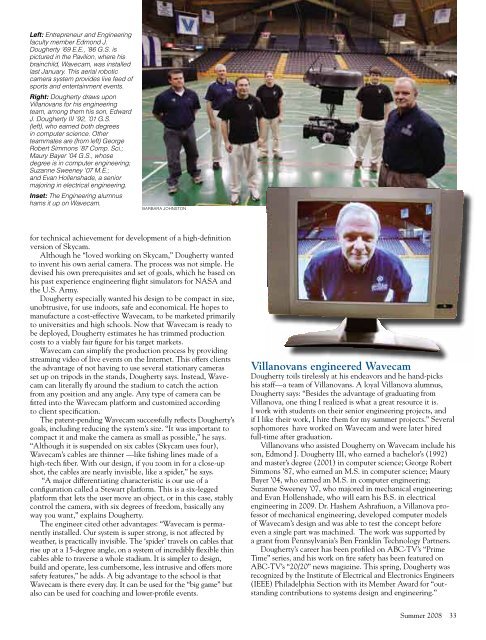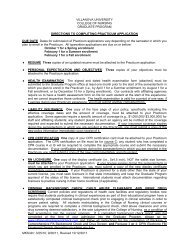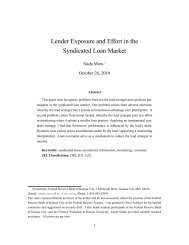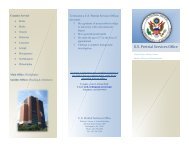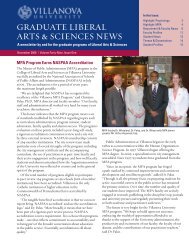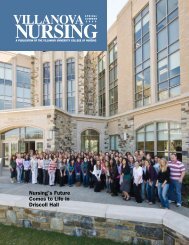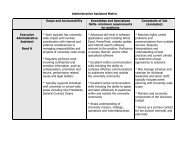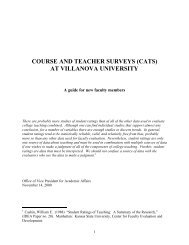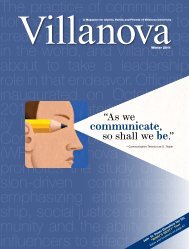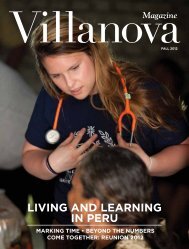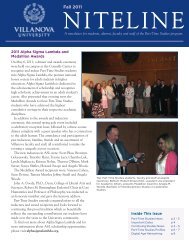A Word from the President - Villanova University
A Word from the President - Villanova University
A Word from the President - Villanova University
You also want an ePaper? Increase the reach of your titles
YUMPU automatically turns print PDFs into web optimized ePapers that Google loves.
Left: Entrepreneur and Engineering<br />
faculty member Edmond J.<br />
Dougherty ’69 E.E., ’86 G.S. is<br />
pictured in <strong>the</strong> Pavilion, where his<br />
brainchild, Wavecam, was installed<br />
last January. This aerial robotic<br />
camera system provides live feed of<br />
sports and entertainment events.<br />
Right: Dougherty draws upon<br />
<strong>Villanova</strong>ns for his engineering<br />
team, among <strong>the</strong>m his son, Edward<br />
J. Dougherty III ’92, ’01 G.S.<br />
(left), who earned both degrees<br />
in computer science. O<strong>the</strong>r<br />
teammates are (<strong>from</strong> left) George<br />
Robert Simmons ’87 Comp. Sci.;<br />
Maury Bayer ’04 G.S., whose<br />
degree is in computer engineering;<br />
Suzanne Sweeney ’07 M.E.;<br />
and Evan Hollenshade, a senior<br />
majoring in electrical engineering.<br />
Inset: The Engineering alumnus<br />
hams it up on Wavecam.<br />
Barbara Johnston<br />
for technical achievement for development of a high-definition<br />
version of Skycam.<br />
Although he “loved working on Skycam,” Dougherty wanted<br />
to invent his own aerial camera. The process was not simple. He<br />
devised his own prerequisites and set of goals, which he based on<br />
his past experience engineering flight simulators for NASA and<br />
<strong>the</strong> U.S. Army.<br />
Dougherty especially wanted his design to be compact in size,<br />
unobtrusive, for use indoors, safe and economical. He hopes to<br />
manufacture a cost-effective Wavecam, to be marketed primarily<br />
to universities and high schools. Now that Wavecam is ready to<br />
be deployed, Dougherty estimates he has trimmed production<br />
costs to a viably fair figure for his target markets.<br />
Wavecam can simplify <strong>the</strong> production process by providing<br />
streaming video of live events on <strong>the</strong> Internet. This offers clients<br />
<strong>the</strong> advantage of not having to use several stationary cameras<br />
set up on tripods in <strong>the</strong> stands, Dougherty says. Instead, Wavecam<br />
can literally fly around <strong>the</strong> stadium to catch <strong>the</strong> action<br />
<strong>from</strong> any position and any angle. Any type of camera can be<br />
fitted into <strong>the</strong> Wavecam platform and customized according<br />
to client specification.<br />
The patent-pending Wavecam successfully reflects Dougherty’s<br />
goals, including reducing <strong>the</strong> system’s size. “It was important to<br />
compact it and make <strong>the</strong> camera as small as possible,” he says.<br />
“Although it is suspended on six cables (Skycam uses four),<br />
Wavecam’s cables are thinner —like fishing lines made of a<br />
high-tech fiber. With our design, if you zoom in for a close-up<br />
shot, <strong>the</strong> cables are nearly invisible, like a spider,” he says.<br />
“A major differentiating characteristic is our use of a<br />
configuration called a Stewart platform. This is a six-legged<br />
platform that lets <strong>the</strong> user move an object, or in this case, stably<br />
control <strong>the</strong> camera, with six degrees of freedom, basically any<br />
way you want,” explains Dougherty.<br />
The engineer cited o<strong>the</strong>r advantages: “Wavecam is permanently<br />
installed. Our system is super strong, is not affected by<br />
wea<strong>the</strong>r, is practically invisible. The ‘spider’ travels on cables that<br />
rise up at a 15-degree angle, on a system of incredibly flexible thin<br />
cables able to traverse a whole stadium. It is simpler to design,<br />
build and operate, less cumbersome, less intrusive and offers more<br />
safety features,” he adds. A big advantage to <strong>the</strong> school is that<br />
Wavecam is <strong>the</strong>re every day. It can be used for <strong>the</strong> “big game” but<br />
also can be used for coaching and lower-profile events.<br />
<strong>Villanova</strong>ns engineered Wavecam<br />
Dougherty toils tirelessly at his endeavors and he hand-picks<br />
his staff—a team of <strong>Villanova</strong>ns. A loyal <strong>Villanova</strong> alumnus,<br />
Dougherty says: “Besides <strong>the</strong> advantage of graduating <strong>from</strong><br />
<strong>Villanova</strong>, one thing I realized is what a great resource it is.<br />
I work with students on <strong>the</strong>ir senior engineering projects, and<br />
if I like <strong>the</strong>ir work, I hire <strong>the</strong>m for my summer projects.” Several<br />
sophomores have worked on Wavecam and were later hired<br />
full-time after graduation.<br />
<strong>Villanova</strong>ns who assisted Dougherty on Wavecam include his<br />
son, Edmond J. Dougherty III, who earned a bachelor’s (1992)<br />
and master’s degree (2001) in computer science; George Robert<br />
Simmons ’87, who earned an M.S. in computer science; Maury<br />
Bayer ’04, who earned an M.S. in computer engineering;<br />
Suzanne Sweeney ’07, who majored in mechanical engineering;<br />
and Evan Hollenshade, who will earn his B.S. in electrical<br />
engineering in 2009. Dr. Hashem Ashrafiuon, a <strong>Villanova</strong> professor<br />
of mechanical engineering, developed computer models<br />
of Wavecam’s design and was able to test <strong>the</strong> concept before<br />
even a single part was machined. The work was supported by<br />
a grant <strong>from</strong> Pennsylvania’s Ben Franklin Technology Partners.<br />
Dougherty’s career has been profiled on ABC-TV’s “Prime<br />
Time” series, and his work on fire safety has been featured on<br />
ABC-TV’s “20/20” news magazine. This spring, Dougherty was<br />
recognized by <strong>the</strong> Institute of Electrical and Electronics Engineers<br />
(IEEE) Philadelphia Section with its Member Award for “outstanding<br />
contributions to systems design and engineering.”<br />
Summer 2008 33


